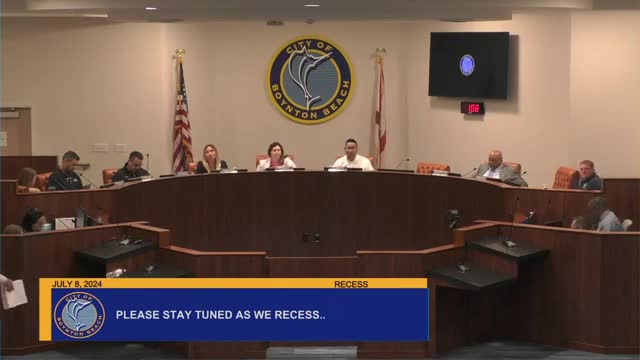Fire Chief proposes critical funding for safety upgrades
July 08, 2024 | Boynton Beach, Palm Beach County, Florida

This article was created by AI summarizing key points discussed. AI makes mistakes, so for full details and context, please refer to the video of the full meeting. Please report any errors so we can fix them. Report an error »

During a recent government meeting, Boynton Beach Fire Chief Hugh Bridal presented a comprehensive overview of the fire department's budget and operational updates, emphasizing the critical importance of public safety and interdepartmental collaboration.
Chief Bridal highlighted a significant 16.6% increase in the fire department's budget, primarily driven by fleet maintenance and rising fuel costs, which now total approximately $280,000 annually. The integration of the Ocean Rescue Department into the fire rescue framework was also noted, resulting in a budget increase of about $1 million. This integration aims to enhance response capabilities and improve operational efficiency.
The chief discussed ongoing negotiations for a new 10-year contract with the Village of Gulf, which is expected to yield an additional $30,000 in revenue. This contract renewal reflects the department's strong reputation and service quality, as the village seeks to continue its partnership with the fire department.
Bridal also addressed the need for additional staffing, proposing three new positions: a lifeguard, a fire prevention inspector, and a logistics coordinator. The latter is particularly crucial for managing the department's extensive equipment inventory, which has been challenging under the current staffing model. The chief emphasized that these positions would be revenue-neutral, as the fire prevention bureau's fees are expected to cover the associated costs.
In terms of community engagement, the chief announced the revival of the Community Emergency Response Team (CERT) program, which had been dormant since the COVID-19 pandemic. This program is vital for enhancing community preparedness during emergencies.
Bridal underscored the importance of maintaining and upgrading the department's infrastructure, including plans for a new fire station and improvements to the emergency operations center (EOC). He expressed confidence that these upgrades would enhance the department's response capabilities, particularly in light of the city's growing population, which has increased by approximately 30% since 2010.
The chief concluded by discussing the necessity of a fire assessment fee, which would provide a dedicated funding source for fire operations and infrastructure improvements, independent of the fluctuations in ad valorem tax revenue. This fee is seen as essential for ensuring the department can continue to meet the community's safety needs effectively.
Overall, the meeting highlighted the fire department's proactive approach to addressing challenges, enhancing public safety, and ensuring the well-being of both its personnel and the community it serves.
Chief Bridal highlighted a significant 16.6% increase in the fire department's budget, primarily driven by fleet maintenance and rising fuel costs, which now total approximately $280,000 annually. The integration of the Ocean Rescue Department into the fire rescue framework was also noted, resulting in a budget increase of about $1 million. This integration aims to enhance response capabilities and improve operational efficiency.
The chief discussed ongoing negotiations for a new 10-year contract with the Village of Gulf, which is expected to yield an additional $30,000 in revenue. This contract renewal reflects the department's strong reputation and service quality, as the village seeks to continue its partnership with the fire department.
Bridal also addressed the need for additional staffing, proposing three new positions: a lifeguard, a fire prevention inspector, and a logistics coordinator. The latter is particularly crucial for managing the department's extensive equipment inventory, which has been challenging under the current staffing model. The chief emphasized that these positions would be revenue-neutral, as the fire prevention bureau's fees are expected to cover the associated costs.
In terms of community engagement, the chief announced the revival of the Community Emergency Response Team (CERT) program, which had been dormant since the COVID-19 pandemic. This program is vital for enhancing community preparedness during emergencies.
Bridal underscored the importance of maintaining and upgrading the department's infrastructure, including plans for a new fire station and improvements to the emergency operations center (EOC). He expressed confidence that these upgrades would enhance the department's response capabilities, particularly in light of the city's growing population, which has increased by approximately 30% since 2010.
The chief concluded by discussing the necessity of a fire assessment fee, which would provide a dedicated funding source for fire operations and infrastructure improvements, independent of the fluctuations in ad valorem tax revenue. This fee is seen as essential for ensuring the department can continue to meet the community's safety needs effectively.
Overall, the meeting highlighted the fire department's proactive approach to addressing challenges, enhancing public safety, and ensuring the well-being of both its personnel and the community it serves.
View full meeting
This article is based on a recent meeting—watch the full video and explore the complete transcript for deeper insights into the discussion.
View full meeting